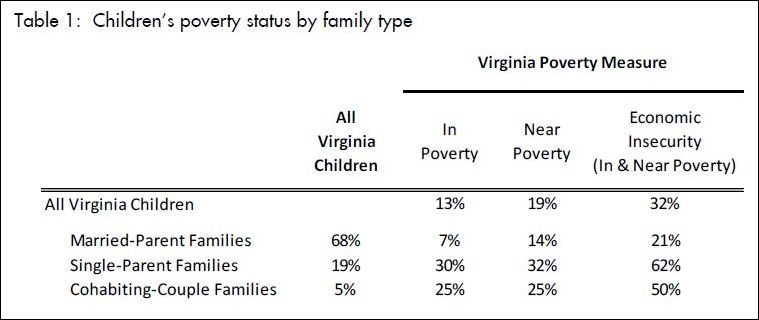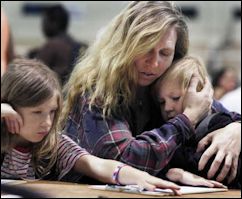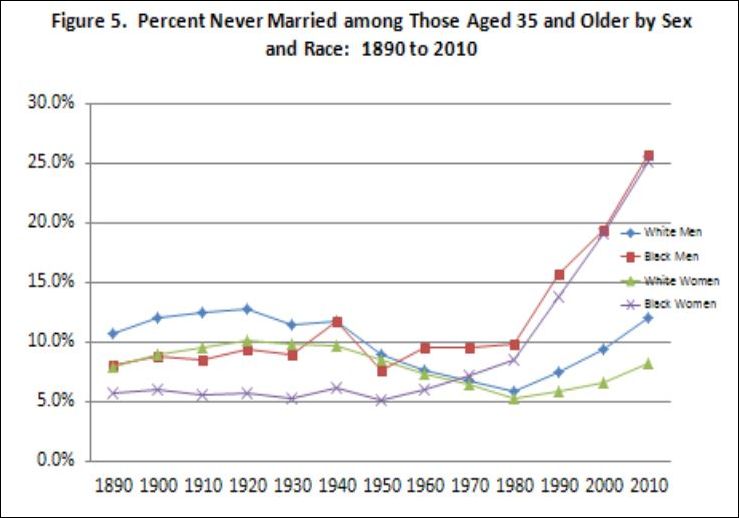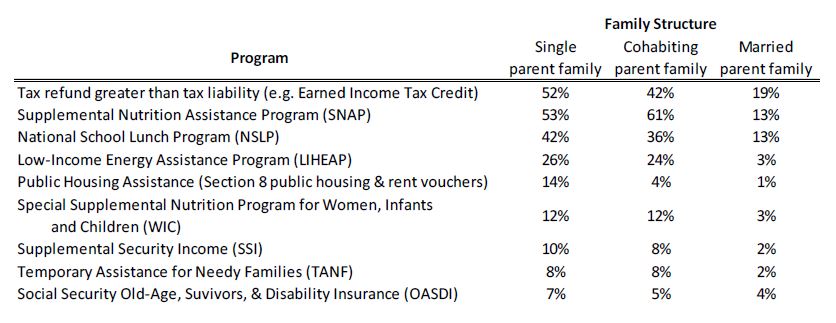by James A. Bacon
Consider the following progression in logic:
– One in three Virginia children live in poverty or near poverty, and half of these children live in married families.
– Marriage alone does not protect children from poverty; indeed, there is little evidence that marriage, as opposed to influences associated with marriage such as the level of education, keeps children out of poverty.
– Rather than promote marriage, public policy should focus on building the “child support system” — cranking up enforcement of child support payments, allowing families that collect child support to continue receiving public support, ramping up Head Start and spending more on universal pre-K.
That’s the thrust of a paper, “New Insights into Childhood Poverty,” just published by the Demographics Research Group of the Weldon Cooper Center for Public Service. The paper represents a major departure for the University of Virginia-based research center, which is best known for its anodyne analysis of demographic trends in the commonwealth. The idea that the best remedy for poverty is more government spending is likely to be a controversial one in Virginia. Actually, that’s an under-statement. While I believe the Demographics Research Group does a lot of useful work — I profile much of it on this blog — I think the group jumped the shark with this publication.
There is so much to object to that I barely know where to begin.
A liberal view of children, marriage and poverty
I will start the discussion by summarizing, as dispassionately as I can, the argument advanced by authors Anna K. Rorem and Megan E. Juelfs-Swanson. The paper can be seen as part of the growing liberal-left intellectual counter-attack on the Welfare Reform Act of 1996, at the heart of which was the belief that marriage played an important role in countering poverty. As the report quotes the Act:
Marriage is the foundation of a successful society… The increase in the number of children receiving public assistance is closely related to the increase in births to unmarried women … it is the sense of Congress that prevention of out-of-wedlock pregnancy and reduction in out-of-wedlock birth are very important Government interests.
The Act encourages the formation and maintenance of two-parent families by means of “marriage promotion programming.” The Commonwealth of Virginia reinforces the Act’s requirements by means of divorce education courses to encourage married couples to stay married.
The authors argue that marriage is no guarantee that children will stay out of poverty. True, as conservatives frequently observe, children living in households headed by unmarried mothers, or even by unmarried mothers living with a boyfriend, are statistically more likely than the children of married parents to live in poverty (less than $22,000 a year for a family of four, according to the federal poverty measure).

But the picture changes if you expand the definition to “near poor,” that is, making less $29,000. Many near-poor households, which encompasses a much larger group of married couples, have recently climbed out of poverty and half of them will recycle back within five years. Roughly half the children of families experiencing “economic insecurity” live in married families. “In other words, while marital status is relevant to rates of childhood poverty, marriage alone does not protect children from poverty.” A commonly held belief holds that two adults in a household create a better environment for children, write Rorem and Juelfs-Swanson: Two parents can mobilize greater financial resources, they can provide more consistent adult supervision and they can more easily juggle the logistics of raising a family, running a households and holding down a job. While the authors don’t attempt to refute such logic, they suggest that other factors do a better job of explaining the relative success of married households in child rearing. Stable marriages are the result of higher income and education, not the cause of it.
Preexisting economic stability improves the likelihood of marriage. People may initiate and sustain a marriage, and children may do better in married-parent families ‘because adults who form and maintain such families are the most stable, well-adjusted, resource-rich individuals.’ Studies also reveal that some low-income couples intentionally delay marriage until they have reached some degree of economic stability. Individuals making this decision may see marriage not as a means toward financial well-being but rather a symbol of it.
Having dispensed with the idea that marriage is related in any meaningful way to staying out of poverty, Rorem and Juelfs-Swanson then suggest that the existing array of government-funded anti-poverty programs needs to be expanded. “Revamping the current child support system would not only improve present-day poverty by raising income in single-parent homes, but would also discourage ‘out-of-wedlock childbearing’ by distributing the cost of raising children across both parents. … Improved early childcare options — including widespread childcare subsidies for low-income families, more funding for Head Start, and a commitment to universal pre-kindergarten — are advocated for their potential to broaden opportunities for all families in poverty.”
A conservative view
There may be some conservatives who hew to the idea that marriage can be sprinkled like fairy dust on the poor and their lives will be magically transformed but I’ve never met them, and I’m certainly not one of them. Poverty is a hard state of affairs regardless of marital status.
Furthermore, if people are raised in a dysfunctional environment in which they are never acculturated to basic norms of civilized behavior, they are not likely to make good marriage partners. In other words, encouraging marriage between individuals who are too immature to maintain respectful, stable relationships is probably a dead-end policy. Some people are unlikely to make good parents whether they are married are not. I object to the idea, however, that a condition of material poverty is detrimental with the institution of marriage. All we have to do is look at the prevalence of marriage over the past century. We can see from this graph published in “Historical Marriage Trends from 1890-2010“:
The percentage of “never married” Americans has surged since 1980s for both whites and blacks. For whites, the percentage of unmarried men and women remains within the range of historical norms. Blacks, who once were more likely to be married than whites, have broken into social and demographic terra incognita. During the Jim Crow era of endemic discrimination, when the overwhelming majority of blacks were poor, the institution of marriage somehow thrived — most likely because, before the welfare state, two sources of income were better than one. In other words, marriage was an institution that effectively provided poor families a measure of protection against the hazards of insecure employment and low wages.
The million dollar question: If stable marriages come from “stable, resource-rich individuals,” how come marriage was so much more prevalent and stable among the laboring classes a century ago when material poverty and insecurity was so much more prevalent than it is today?
There have been two sea changes over the past century. First was the sexual revolution and the collapse of social norms against divorce and unwed pregnancy. Social norms held marriages together a century ago even when the couples were unhappy. The second was the rise of the welfare state, which undermined marriage as an economic institution. Over the past 40 years, the panoply of welfare benefits has rendered the financial contribution of men in lower-income households increasingly superfluous. You can see how extensive those benefits from the chart, thoughtfully published in the Weldon Cooper report, below:
The theory that marriage is the province of “resource-rich” individuals is a liberal fantasy concocted to explain away the devastating impact of the welfare state upon the family structure of the very people they purported to help. According to liberal theory, the marriage among lower-income Americans should have increased as the welfare state ameliorating economic insecurity. In the case of African-Americans, that theory is devastatingly disproven by the facts.
Rorem and Juelfs-Swanson don’t appear to see the marginalization of lower-income men as any great loss in regards to the raising of children. However, the contribution of fathers goes way beyond providing children with “adult supervision” and juggling household chores. Fathers make a critical contribution instilling and reinforcing the values it takes to function in life — self control, self discipline, work ethic, respect for the rights and desires of others, a willingness to defer gratification. That’s not to say that children can’t learn those values from their mother alone, but the mother’s job is much harder. Two-parent parenting is hard; single-parent parenting is doubly hard.
This gets us to the confusion over the source of “privilege” in our society, which liberals confuse with material abundance and conservatives rightly understand as a proper upbringing. Liberals believe in the magical power of money to infuse children with the values and character it takes to graduate from high school, earn a college degree, progress along a career path, enter into a stable marriage and raise healthy, balanced children. If you are raised in affluence, you are destined to success; if you are raised in poverty, your chances of upward mobility are severely stunted. By contrast, conservatives believe that the real source of “privilege” in society is parents who inculcate strong values, something that no amount of money can buy. Anyone with strong values and character can rise above their station; anyone lacking those traits can slide into the abyss.
Teaching those values is a two-person job. Absentee fathers may send child-support checks but if they do not participate in raising their children, the children face much longer odds in life. The act of getting married is not a panacea; as a rule, substance abusers and serial adulterers don’t make good husbands and fathers. But the institution of marriage seen as part of a broader life strategy — getting an education first, getting a job, then getting married, and then having children — is a far more effective life path than having children, dropping out of school, and then cohabitating with someone far more likely than a biological parent to abuse the children.
We’ve traveled down dysfunctional-family path for 60 years now and we’ve seen what happens. Government programs may temporarily ameliorate material poverty but they beget spiritual poverty. We need less government, more personal responsibility.





